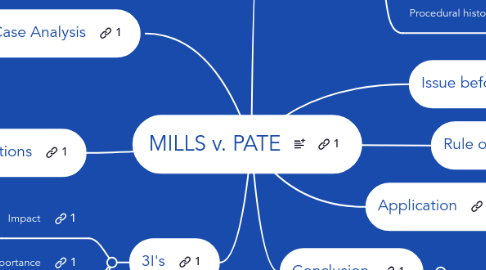
1. M2 IRAC Case Analysis
1.1. Joyceline MILLS v. Dr. John PATE, M.D. 225 S.W.3d 277 Court of Appeals of Texas, El Paso. No. 08–04–00335–CV. | June 1, 2006
2. Citations
2.1. https://www.courtlistener.com/opinion/1768891/mills-v-pate/
2.2. http://www.juritool.com/court-case-lookup/summary-judgment--material-fact--593128639.htm
2.3. Battin v. Samaniego, 23 S.W.3d 183 – CourtListener.com
2.4. FindLaw's Court of Appeals of Texas case and opinions.
3. 3I's
3.1. Impact
3.1.1. Patients may be left with abnormalities if they are unable to establish that informed consent was not sufficient, and if they cannot produce evidence of warranty.
3.1.1.1. Facts
3.1.1.1.1. Ms. Cassisi purchased a clothes dryer, which she claims was used according to manufacturers directions
3.1.1.1.2. After 19 months of use, she started the dryer, left home and returned to a home ravaged by fire.
3.1.1.2. Procedure
3.1.1.2.1. Ms. Cassisi filed suit for strict liability, negligence, and breach of an implied warranty.
3.1.1.2.2. Appellant's expert testified the fire started within the dryer, concluding there must be a material defect within the dryer
3.1.1.2.3. Appellees argued appellants' burden was not met because their evidence failed to pinpoint a defect inside the clothes dryer either at the time of the accident or at the time the product left the control of the manufacturer or supplier.
3.1.1.3. Conclusion
3.1.1.3.1. Courts held that a "`defective condition' within the meaning of Section 402A [can be established] by proving ... the product functioned improperly in the absence of abnormal use and reasonable secondary causes."
3.2. Importance
3.2.1. Due diligence: The patient is responsible for conducting a thorough search before agreeing to a procedure of this nature. It is highly likely that by checking references, getting recommendations from friends, and speaking directly with former patients--and checking for complaints, more information would have been revealed about the likely outcome of the liposuction.
3.2.2. Written warranty: Many patients do not read the informed consent--which was the determining instrument in this case. In addition, patients should ensure any guarantees are in writing.
3.3. Influence
3.3.1. In 2003, the Legislature repealed the Medical Liability and Insurance Improvement Act. It was replaced with Chapter 74 of the Civil Practices and Remedies Code
4. Application
4.1. Physcian's
4.1.1. Misrepresentation
4.1.1.1. Type 1-Persuasion: Marketing & advertising are essential to secure market share. Physicians must ensure advertisements, such as brochures and commercials are transparent and accurately reflect the services & expected outcomes.
4.1.1.1.1. FTC Guidance: Physicians can study pharma advertisements to learn how they apply (are supposed to apply) the FTC guidelines for DTC marketing. This is a good resource since pharma is the biggest healthcare "advertiser" of treatments & outcomes.
4.1.1.2. Type 2-Patient results: Cosmetic surgeons are the single largest group of doctors that use visual aids to educate patients about expected outcomes. It is essential that physicians mitigate risk by ensuring their pre/ post pictures, and communication about past results is true.
4.1.2. Breach of Warranty
4.1.2.1. Statute of Frauds
4.1.2.1.1. "requires that an agreement, promise, contract, or warranty of cure relating to medical care or results thereof made by a physician or health care provider under the Act, must be in writing and signed by the person to be charged with the promise or agreement or by someone lawfully authorized to sign for him."
4.1.2.1.2. NOT having the warranty in writing, creates an affirmative case for patient. The burden to prove otherwise falls on the doctor.
4.1.2.2. NOT having the warranty in writing, creates an affirmative case for patient. The burden to prove otherwise falls on the doctor.
4.1.2.2.1. In Battin v. Samaniego, it was cited a trial court cannot grant a "no-evidence" motion for summary judgment on an affirmative defense
4.2. Patients
4.2.1. Informed consent & negligence: the rule of law states negligence is failure to disclose, and that disclosure would influence a reasonable persons decision to consent.
4.2.1.1. Negligence is not permissible under informed consent. In Hartfiel v. Owen the courts cited unless the plaintiff can PROVE the informed consent would have prevented agreement to the procedure.
5. Facts
5.1. Parties
5.1.1. Joyceline MILLS, Appellant
5.1.2. Dr. John PATE, M.D., Appellee
5.2. What Happened
5.2.1. Action: MILLS scheduled consultation with PATE after hearing radio advertisement, in which PATE claimed to be an expert liposuction surgeon.
5.2.1.1. opportunity for Misrepresentation
5.2.2. Nov. 1999: MILLS signed an informed consent & permission to perform surgery
5.2.3. Dec. 1999-2001: MILLS undergoes two surgeries. Both of which she claims dissatisfaction and pain
5.2.3.1. Following 2nd surgery, MILLS communicated dissatisfaction with results, including disproportion, bulges, ripples, bagging, and pain. The results were contrary to the alleged promised results.
5.2.4. MILLS consults with a different doctor, who performs body contouring surgery, fixing the alleged abnormalities.
5.2.5. MILLS files suit
5.3. Procedural history
5.3.1. January 23, 2003: MILLS files suit for medical malpractice.
5.3.2. PATE: files motion for partial summary judgment. Argued claims were barred by the two-year statute of limitations contained in Section 10.01 of Article 4590i.
5.3.2.1. PATE: Also filed amended "no evidence" motion citing no evidence of claims
5.3.3. PATE is granted summary judgement on both claims.
5.3.4. MILLS files appeal
5.3.5. Summary judgement affirmed in part. Part of judgement reversed. Case remanded for further proceedings.
6. Issue before Court
6.1. Establish if an express warranty exists; was a specific promise made to yield a specific result
6.2. Establish if there was Informed Consent. If there was, this negates the claim of “negligence in failing to disclose the risks or hazards that could have influenced a reasonable person in making a decision to give or withhold consent."
7. Rule of Law
7.1. Medical Liability and Insurance Improvement Act
7.1.1. Negligence: based on a claimed departure from an accepted standard of medical care, health care, or safety of the patient, whether the action sounds in contract or tort
7.1.2. Express warranty: A guarantee in writing; a subsequent breach of the warranty.
